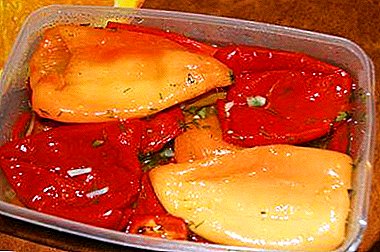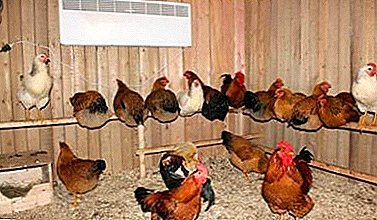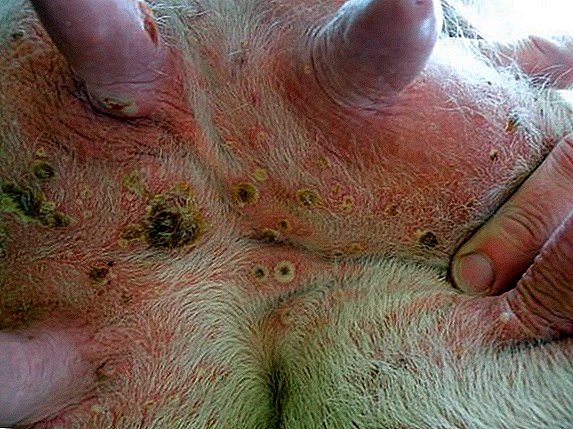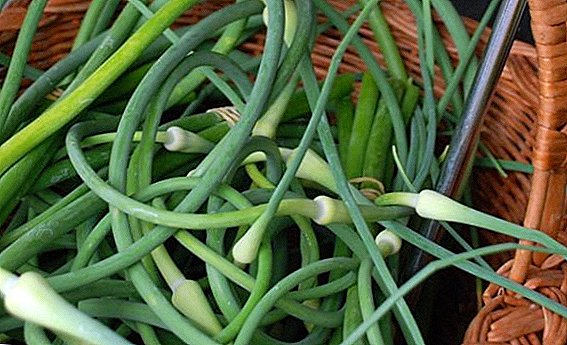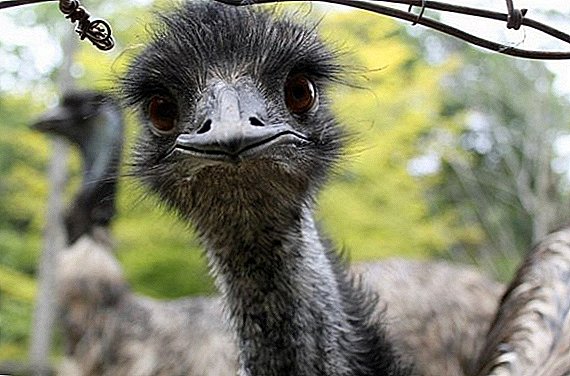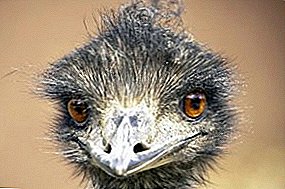 In this article we will talk about an emu - an amazing bird, one of the biggest, deprived of the ability to fly, but a very interesting representative of the animal world.
In this article we will talk about an emu - an amazing bird, one of the biggest, deprived of the ability to fly, but a very interesting representative of the animal world.
What does an emu look like
This original ostrich grows to 1.5-1.8 meters, while gaining weight from 35 to 55 kg.
The bird has a dense body, a small head and a long pale blue neck with rare gray-brown and brown feathers that absorb the sun's radiation, and a spacious (more than 0.3 m) thin-walled bag with a trachea located on it. Eyes are round, protected by blink membrane. The bird has a pink beak with a curved end, its teeth are missing. 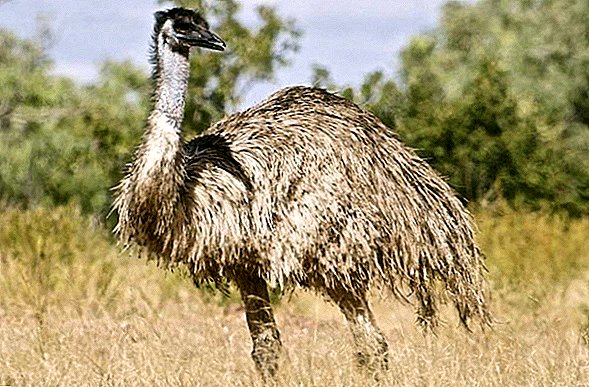 An emu is not a flying bird, and therefore its wings are almost undeveloped: they lack flight and tail feathers. The length of the wings is not more than 25 cm, but on their ends there is a growth in the form of a claw.
An emu is not a flying bird, and therefore its wings are almost undeveloped: they lack flight and tail feathers. The length of the wings is not more than 25 cm, but on their ends there is a growth in the form of a claw.
Strong and developed legs without feathers allow the bird to take a step 2.5 meters long and to run up to 50 kilometers per hour at a short distance. On each leg, the ostrich has three fingers with very sharp claws.
You will probably be interested to know what speed an ostrich develops while running, and whether ostriches hide their heads in the sand in reality.
The plumage of this bird deserves special attention: it is equipped so that the emu does not overheat in the heat, and does not freeze in the cold. Feathers are soft, brown-gray.
What is the difference between an emu and an ostrich?
Although the emu is attributed to ostriches (by the way, quite conditionally: the closest relative of the emu is not an ostrich, but a cazuar), but this bird has certain differences from them, for example:
- An ostrich is much larger than an emu, its weight can reach 150 kg, and an emu is 2-3 times smaller.
- The ostrich on the chest has a place not covered with feathers, the emu does not.
- Ostriches have 2 toes, and emus have 3 toes.
- The ostrich feathers are loose and curly, while the emu has structural feathers that resemble wool.
- Emus, unlike ostriches, is characterized by limited monogamy: one or two females.
- Emu are eggs of dark color, and ostriches are white.
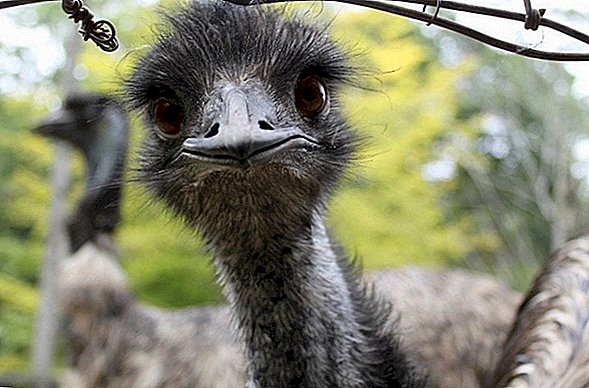
Where dwells
The bird lives mainly in Australia, in the savannah, where there is a lot of grass and bushes, but you can meet it in Tasmania. Dislikes noisy and populated areas, arid places and dense forests. Favorite place to visit - sown fields, which cause significant harm. An emu is a loner, but sometimes it can be in a group of 3-5 individuals.
Did you know? Ostrich has more eyes than an elephant's eye.
Lifestyle and character
By nature, this bird is a nomad: it moves from place to place mainly in search of food, and with its long stride it is not difficult to overcome several tens of kilometers.
In the daytime, in the very sun, he rests somewhere in the shade, in the undergrowth, but in the evening, when the heat subsides, the emu becomes active, but only in the evening, the night for him is a deep sleep. To do this, he settles on the ground, stretches his neck and so sleeps. But doze him better sitting, closing his eyes half. 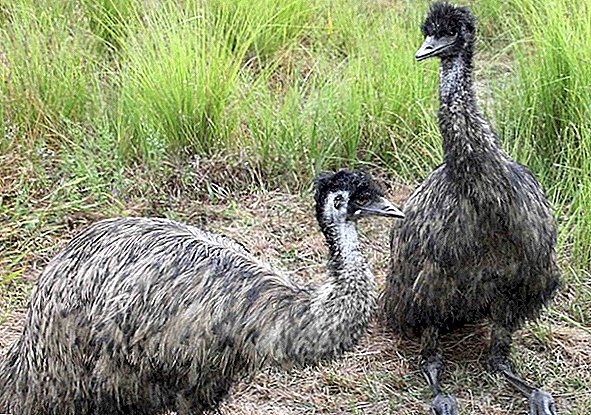 It is believed that an emu is a stupid bird, but its stupidity is more than compensated for by caution: even when it feeds, it periodically pulls its neck and listens to what is happening around it, and if it senses something bad, it will begin to run away from danger. However, the bird has almost no enemies in the wild - its claws on its legs can kill.
It is believed that an emu is a stupid bird, but its stupidity is more than compensated for by caution: even when it feeds, it periodically pulls its neck and listens to what is happening around it, and if it senses something bad, it will begin to run away from danger. However, the bird has almost no enemies in the wild - its claws on its legs can kill.
Emu likes to be on its own, not coming close to people or large representatives of the animal world, but sometimes it does not mind joining a small group of relatives. In natural conditions lives up to 15 years, but in conditions of bondage - up to 25.
Did you know? Striking an ostrich can kill a lion.
What emu eats
In the diet is not picky, rather, omnivorous, but the basis of its diet are plants. It feeds usually in the morning. Can eat and mice, lizards, insects, small birds. He swallows food, and then he throws small pebbles and sand into his stomach, which already grind food that had already got there. 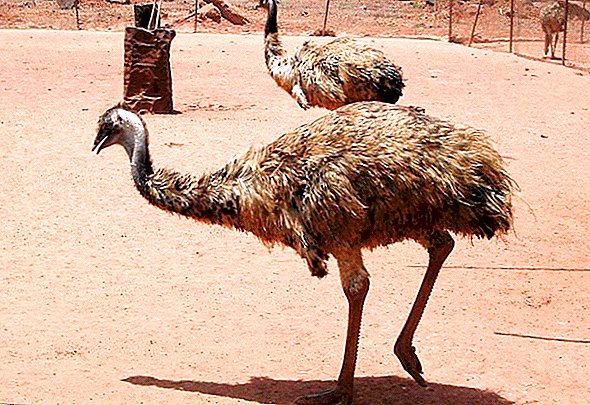 The water in his diet - not the main thing, without it he can do for a long time. In a reservoir encountered on the way, it can quench thirst and also bathe.
The water in his diet - not the main thing, without it he can do for a long time. In a reservoir encountered on the way, it can quench thirst and also bathe.
Learn more about breeding ostriches at home, as well as what ostriches eat in the wild and at home.
Breeding
Approximately at the age of two years, an emu develops puberty, and in the coming December-January, the breeding season begins, which is preceded by mating games. First, the male calls the female with its special sounds, then they stand against each other, lower their heads to the ground and swing them in different directions, and then go to the place of laying prepared by the male beforehand - a small depression in the ground, lined with dry leaves and grass.
The female lays one egg, as a rule, daily, but it happens that this happens in a day or two. On average, from 11 to 20 pieces weighing 700-900 g each come out.  In the photo on the left (dark green) - emu eggs, on the right (white) - ostrich But dad hatching eggs and for him it is a difficult period: for about two months he leaves the nest only to eat and drink, and even then not far away and not for long. After 56 days, the chicks appear covered with fluff and already sighted, after 2-3 days they are able to leave the nest, and another day later - accompany dad from the back, wherever he goes.
In the photo on the left (dark green) - emu eggs, on the right (white) - ostrich But dad hatching eggs and for him it is a difficult period: for about two months he leaves the nest only to eat and drink, and even then not far away and not for long. After 56 days, the chicks appear covered with fluff and already sighted, after 2-3 days they are able to leave the nest, and another day later - accompany dad from the back, wherever he goes.
The next 7-8 months only the father takes care of the offspring, the female does not take any part in the later life of the offspring.
Did you know? In emu, the brain and eyes are the same size.
Why is their numbers very reduced
The main reason for the decline in the number of these birds is their destruction by man.
In the 20s-30s of the last century agriculture actively began to develop in Australia, the area of arable land expanded significantly. At the same time, the emu population, dramatically increased due to migration, in search of easy food production began to make raids on farms and cultivated land. They ate and damaged crops, broke holes in fences, through which rodents then penetrated. 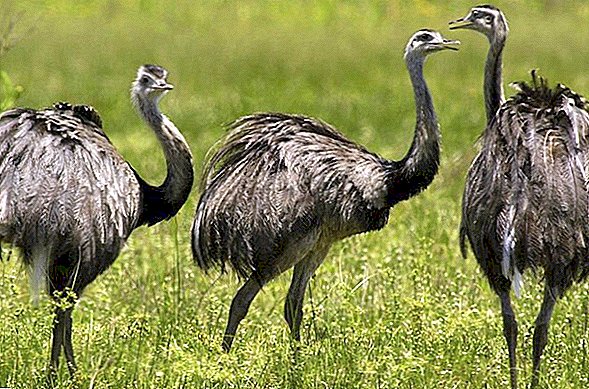 The Australian government received tens of thousands of complaints from farmers about the invasion of ostriches and the damage they caused. The so-called "war with emu" was started, when birds were tried to shoot (three hunters were assigned, two Lewis machine guns and ten thousand cartridges were allocated). And when this method did not bring the expected results, the government resumed the previously introduced system of incentives for the independent elimination of ostriches. As a result, in only six months of 1934 over 57 thousand of these birds were destroyed.
The Australian government received tens of thousands of complaints from farmers about the invasion of ostriches and the damage they caused. The so-called "war with emu" was started, when birds were tried to shoot (three hunters were assigned, two Lewis machine guns and ten thousand cartridges were allocated). And when this method did not bring the expected results, the government resumed the previously introduced system of incentives for the independent elimination of ostriches. As a result, in only six months of 1934 over 57 thousand of these birds were destroyed.
We recommend to learn how to incubate ostrich eggs at home and how to save ostrich eggs before incubation.
Maintenance and care at home
The ability of the emu to adapt to new conditions and unpretentiousness to the feed became the reason for their active farming, including in the northern countries. Consider the conditions of detention of these exotic birds and care for them. 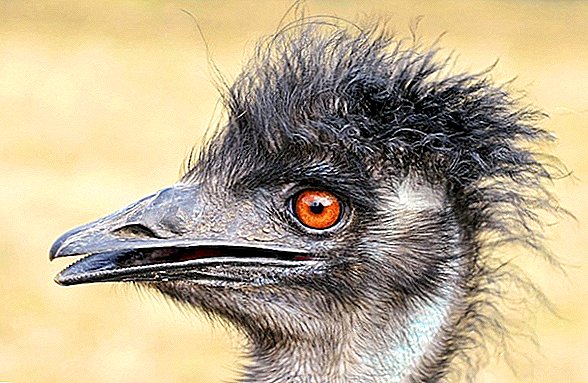
Room Requirements
When equipping the premises should consider the following requirements:
- Square. When kept in stalls, the calculation for an adult is 10-15 square meters. m, and growing up - 5 square meters. m
- The litter should be thick and comfortable.
- Timely cleaning and disinfection of the floor.
- Ensuring continuous air circulation (enough if there will be opening windows).
- Maintaining the optimum temperature regime - from +10 to + 24 ° С, and up to + 30 ° С in winter and during incubation.
- Equipment troughs and drinkers, given the growth of livestock.
Aviary for walking
The site should be spacious, for an adult individual not less than 50-60 square meters. m. with a separate pen with a canopy so that the birds can hide from the sun. 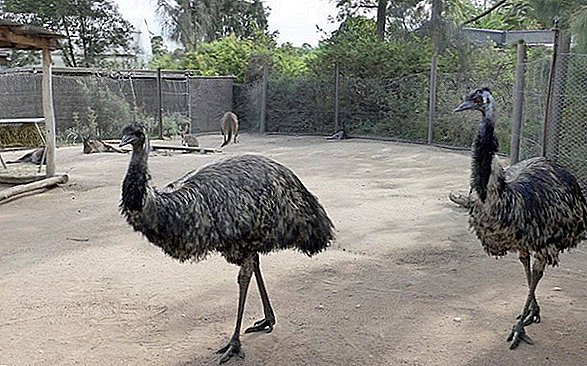 The enclosure of the enclosure should be equipped with a height of 1.5-1.8 m. The fine mesh is ideal for a hedge - an emu cannot stick its head and be injured.
The enclosure of the enclosure should be equipped with a height of 1.5-1.8 m. The fine mesh is ideal for a hedge - an emu cannot stick its head and be injured.
Important! The sharp edges of the fence mesh should be sanded to protect ostriches from injury.
How to endure winter cold
These ostriches adapt well to the cold and can feel good even at -20 ° C.
What to feed
At home, cereal crops are suitable for forage, in the summer season - freshly cut grass, and in wintertime - hay.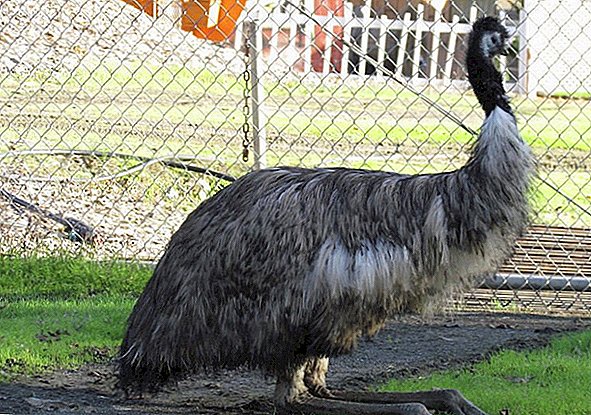 Mineral-vitamin complexes, grain mash, bone meal, chicken eggs, meat and bread are used as feed additives. The ration of poultry should be half full of juicy and coarse feed.
Mineral-vitamin complexes, grain mash, bone meal, chicken eggs, meat and bread are used as feed additives. The ration of poultry should be half full of juicy and coarse feed.
Important! Per day, an adult emu should receive no more than three kilograms of food. Otherwise, overeating will begin, which, in turn, will lead to excess weight and curvature of the limbs.
Emus Eggs and Meat: Benefits, Cooking Applications
Speaking of emu eggs, it should be noted that it is a storehouse of beneficial nutrients. They contain:
- Phosphorus.
- Iron.
- Vitamins of group B - folic acid and cobalamin.
- Retinol.
- Calciferol.
In eggs, about 68% of polyunsaturated fats and 31% of saturated fats are useful to humans, and they also contain 8 essential amino acids for people. 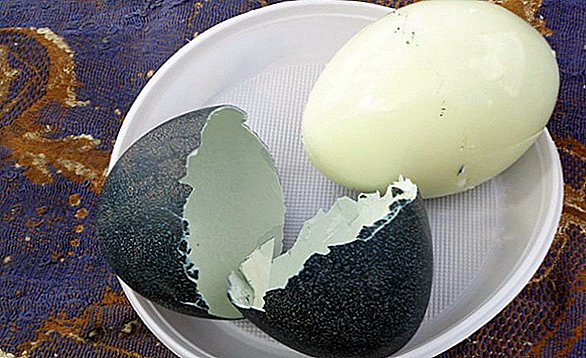 Nutritional value of the product (per 100 g):
Nutritional value of the product (per 100 g):
- Belkov - 14 years
- Fat - 13.5 g
- Carbohydrates - 1.5 g.
- Ashes - 1.3 g
- Water - 74 7.
The total calories - 160 kcal. In cooking, eggs are fried, boiled, baked, but best of all, according to experienced cooks, they are suitable for baking savory dishes. They make light snacks and omelets: to prepare an omelet for seven people, you will need only one emu egg.
Did you know? One emu egg can replace up to 30-40 chicken eggs.Experts consider the meat of this bird to be a dietary delicacy: its fat content is not more than 1.5%, and its cholesterol is only 85 mg per 100 g of meat. Another advantage of the product is low calorie content: per 100 g not more than 98 kcal.
The most valuable and tasty meat part is fillet. It is recommended for people suffering from diabetes, diseases of the gastrointestinal tract, as well as those who have high cholesterol. Protein, which is very abundant in meat, is a catalyst for metabolism in the body. Properly prepared product will provide a good metabolism and better absorption of vitamins. 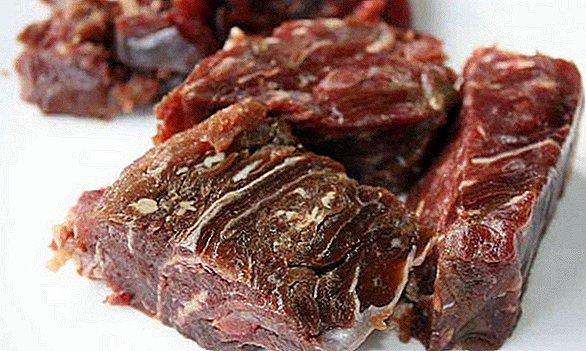 There are so many useful nutrients in emu meat that a portion of 150-200 g replenishes 50% of the daily balance of nutrients.
There are so many useful nutrients in emu meat that a portion of 150-200 g replenishes 50% of the daily balance of nutrients.
We advise you to learn about the benefits and methods of cooking meat poultry: geese, chickens, ducks, turkeys, peacocks.
Poultry meat contains:
- Complex of vitamins of group B.
- Vitamin E.
- Niacin.
- Iron.
- Phosphorus.
- Zinc.
- Copper.
- Selenium.
- Calcium.
- Potassium.
- Magnesium.
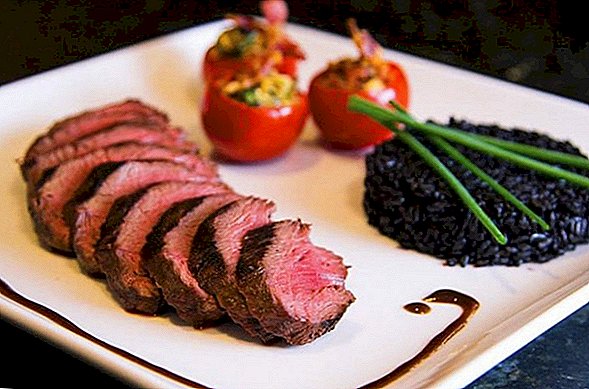 Emu ostrich, a native of faraway Australia, is now distributed almost all over the world, it is bred on ostrich farms in many countries and is valued for quality products that are useful to humans.
Emu ostrich, a native of faraway Australia, is now distributed almost all over the world, it is bred on ostrich farms in many countries and is valued for quality products that are useful to humans.

